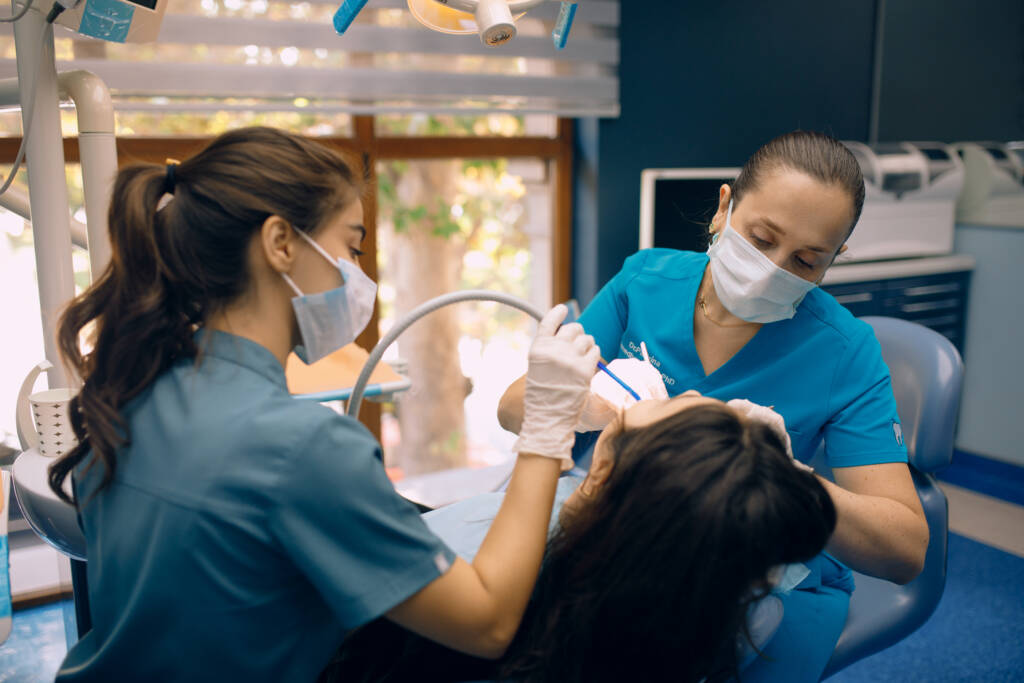
Children up to 16-18 years of age are in a period of active growth, during which their tooth enamel is not yet fully developed, making them highly susceptible to caries. The faster and asymptomatic progression of dental illnesses in children, compared to adults, creates conditions for numerous inflammatory complications. This can lead to the early extraction of teeth and even more complex and challenging forms of surgical treatment, sometimes requiring the hospitalization of children.
Therefore, the supervision of a skilled expert over a child’s development from the first year of life ensures timely correction and potential preventive measures. We offer a comprehensive range of services in pediatric dentistry:
Prevention of caries and its complications using deep fluoride treatment on tooth surfaces.
Effective protection against caries through the hermetic sealing of fissures.
Caries prevention in cases of enamel formation irregularities.
Treatment of caries in deciduous teeth using colored fillings.
Treatment of pulpitis in deciduous teeth (which differs from adults).
Our unique method of chemically processing carious cavities allows for treatment without the need for a drill, making the process painless. The pediatric dentist in our clinic will conduct a full range of preventive actions necessary for the young patient: determining a hygienic index, polishing teeth with professional pastes, performing hermetic sealing of healthy fissures, and applying deep fluoride treatment.
The Pediatric Dentistry delivers comprehensive oral and dental healthcare services tailored for individuals from birth to the conclusion of puberty (0 – 16 year-olds). This is achieved through the implementation of conservative, preventive, and therapeutic procedures. Scope of practice encompasses:
– Implementation of preventive measures for dental caries: Focus on measures to prevent the occurrence of dental caries through oral hygiene practices, fluoride treatments, and dietary guidance.
– Restoration of carious primary and permanent teeth: Performing procedures to restore teeth affected by dental caries, including the application of fillings or other restorative materials.
– Extraction of teeth deemed to have a hopeless prognosis: Removal of teeth that are unlikely to recover or be successfully treated due to severe damage or disease.
– Mitigation of adverse effects resulting from early teeth extractions using appliances to ensure proper eruption sequencing: Addressing potential issues arising from early tooth extractions by utilizing appliances to guide the proper sequence of tooth eruption.
– Diagnosis and treatment of traumatic dental and supporting tissue injuries, followed by long-term monitoring: Identifying and treating injuries to teeth and supporting tissues resulting from trauma, with ongoing monitoring for long-term health.
– Monitoring of tooth eruption, teething, and prevention of anomalies in eruption patterns: Observing and managing the natural process of tooth eruption and teething, as well as preventing any irregularities in the pattern of tooth eruption.
– Diagnosis, treatment, and follow-up of periodontal diseases (gum diseases) observed during childhood or adolescence: Identifying, treating, and monitoring gum diseases that may occur in children or adolescents, ensuring ongoing oral health.
Beyond catering to the oral health of healthy children and adolescents, the Pediatric Dentistry extends its services to patients with special needs, chronic systemic diseases, syndromes, physical disabilities, and learning difficulties.
Specialist dentists conduct the initial examination, diagnosis, and treatment planning for patients. In cases where a radiographic examination is necessary for diagnosis and treatment planning, patients are referred to the Dentomaxillofacial Radiology, accompanied by their parents. Upon completion of treatment planning, patients receive appointments for ongoing treatments.
For patients lacking cooperation due to being very young or having physical or mental disabilities, undergoing treatment under general anesthesia is facilitated in the operation. This includes individuals with syndromes or those traveling from a distance requiring treatment for multiple teeth at a single visit. A pediatric dentist, in collaboration with an anesthesiologist, administers treatments under operating room conditions.
Post-treatment, periodic recall visits are scheduled based on the caries risk status and specific needs of each patient. The Pediatric Dentistry is positioned as a ‘dental home’ that children and their parents should visit at predetermined intervals until growth and development are complete. Regular and long-term visits contribute to establishing a robust foundation for an individual’s lifetime oral and dental health.


